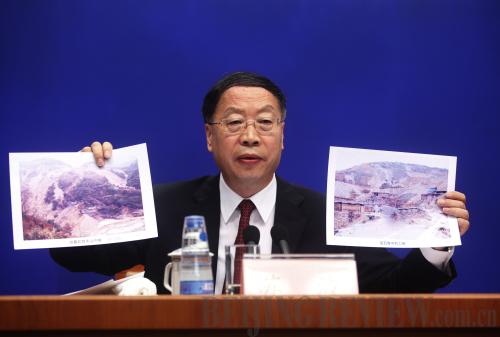|
 |
|
DEVASTATING POLLUTION: Su Bo, Vice Minister of Industry and Information Technology, showcases pictures of a polluted rare earth mining site at a press conference on June 20 (XINHUA) |
Inner Mongolia's Dalahai Village was a place of utopian beauty. With a landscape of lush green hills, exuberant grasslands and herds of sheep and cows, the village used to be the quintessential image of a nice place to live.
Today, the quaint village is gone, replaced by a barren landscape void of life. Cancer cases among the remaining local populace have been on the rise.
What's the reason for the cataclysmic change? Li Guirong, a Dalahai villager, puts the blame on the discovery of rare earths.
"We knew something was wrong sometime in the late1980s when the trees and local vegetation blossomed but didn't bear any fruit," Li said. "Later, they stopped growing at all."
Rare earths, a group of 17 elements, are valuable, non-renewable resources essential in the manufacture of a range of hi-tech products, including wind turbines, laptops and hybrid cars.
China has the richest rare earth reserves in the world, with Baotou in the north and Ganzhou in the south as major reserve zones.
Growing awareness of the dangers of mining rare earths has galvanized the Central Government to act.
At a press conference addressing new government measures to control errant rare earth mining operations, Su Bo, Vice Minister of Industry and Information Technology (MIIT), outlined a series of new government regulations to rein in the sector.
In March, a team led by Su took an inspection tour of a rare earth exploitation site in Ganzhou, Jiangxi Province. The team was shocked by the environmental pollution and the cost to clean up the area, a whopping 38 billion yuan ($5.97 billion).
"China shoulders 95 percent of global rare earth output, at the cost of polluting its environment. This needs to change," said Su. | 